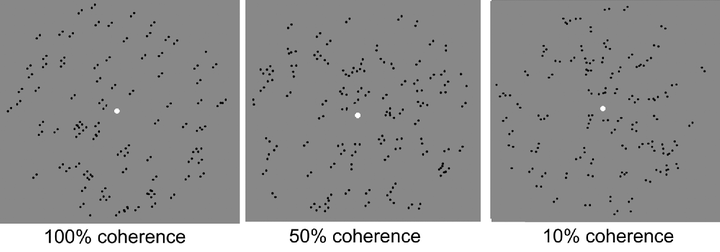 Glass patterns at different coherence levels
Glass patterns at different coherence levels
Abstract
Purpose: Visual deficits in infantile nystagmus syndrome (INS) could be a result of retinal blur from excessive eye movements and/or cortical changes from visual deprivation. We measured global motion and form sensitivity in INS to compare deficits between motion and form perception and to decipher the role of internal noise (local deficit such as eye movement) and sampling efficiency (global cortical deficit).
Methods: A total of 30 participants (14.40 ± 4.83 years) with INS and 30 age-matched controls discriminated the direction of motion and orientation of physically equivalent translational random dot kinematograms (RDKs) and Glass patterns. Both stimuli consisted of 240 black dots (RDKs) and 120 pairs of dipoles (Glass patterns) with a display duration of 1.0 second. Two experimental paradigms were employed: coherence threshold (random noise) and equivalent noise (at five external noise levels).
Results: The mean motion coherence thresholds at 5°/s and 10°/s were higher in INS (50.55% ± 21.33% and 31.87% ± 14.69% respectively) compared to controls (24.04% ± 13.22% and 20.65% ± 12.89, respectively) (P < 0.01). The mean orientation coherence thresholds were also higher in INS (12.23% ± 0.32% vs. 7.88% ± 0.33%; P < 0.01). For the equivalent noise paradigm, thresholds were higher for INS at no noise and 3 lower noise levels (P < 0.01), but similar at the highest noise level (P > 0.01). Higher internal noise best explained the difference in performance between INS and controls for both motion and form (P > 0.05).
Conclusion: INS results in lower sensitivity to both motion and form perception. These deficits are due to higher internal noise, which could arise from early areas of visual processing such as primary visual cortex as a result of abnormal eye movement or effect of early visual deprivation.